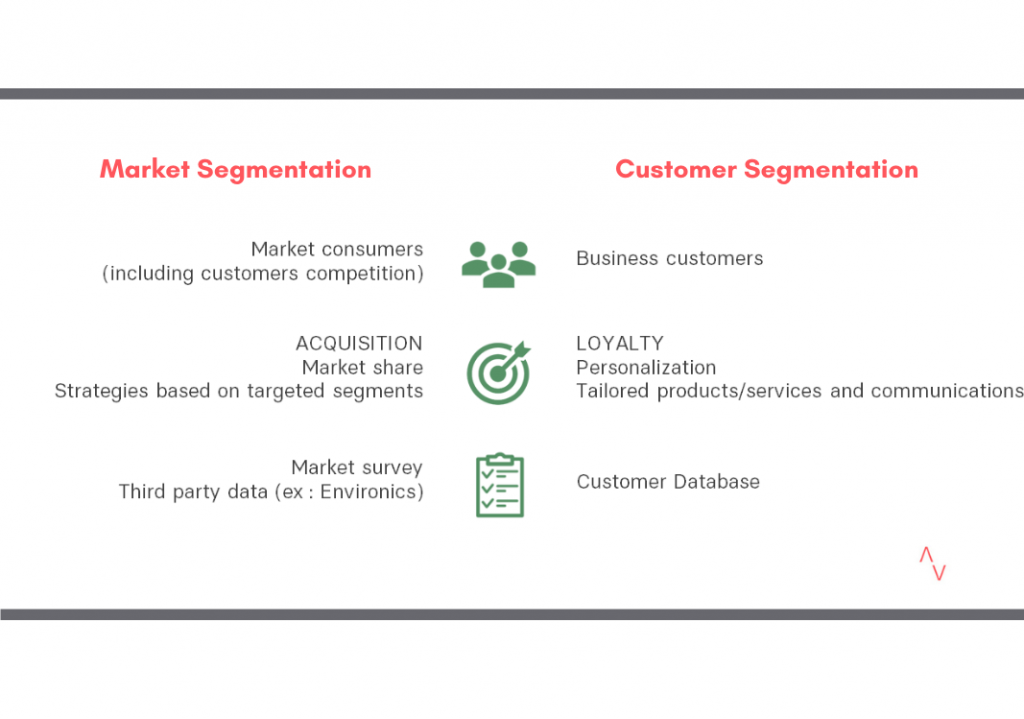@Copyright 2019 Numea
When the time comes to create a consumer segmentation, one can choose between a customer segmentation and a market segmentation. Both serve different purposes. So, if you are tempted by the idea of segmentation, the first question you will have to answer is: what is your objective?

This segmentation is based on all consumers in the market, therefore yours, but also those of your competitors. Consumers can be grouped in several ways: sociodemographic, needs, motivations, behaviors, consumption habits, attitudes, values, and so on.
The objective of market segmentation is to gain market share. Hence the importance of spreading this segmentation throughout the organization so that each division can appropriate it. If marketing is working to attract a segment in its communications, the Web interface, product offering, and service must meet the expectations of these segments. In fact, the entire organization must be aligned with the needs, motivations, and desires of their key segments.
But how can market segmentation help us gain market share?
Focusing on a common vision: Having a common point of reference across the organization helps to identify corporate priorities and align strategies to the same targets. We all speak with one voice to the consumer
To define the value proposition: Identify the segments that have the most value, identify their priority needs, their irritants and better meet their expectations. Make sure that the experience, regardless of the path taken, is optimal and that the segment becomes more attached to your brand. You can develop a service and product offering more specifically tailored to their needs and desires.
To optimize spending: Instead of trying to acquire customers regardless of their quality, you can focus your marketing, sales, and distribution efforts on acquiring segments that are most valuable to YOU.
To identify the appropriate acquisition approach: For a given segment, you can know how and where to reach it, what message will make the most sense, what features your digital platforms should have, and so on.
Customer segmentation is usually done using the internal data you have about your customers. It can come from a variety of sources: a loyalty program, digital or transactional behavioral data. Internal data can also be supplemented with survey data to gain insight into areas such as attitudes and motivations, for example. The important thing is to have data linked to a unique identifier.
While market segmentation is used to guide business strategies, customer segmentation is used to guide marketing strategies and product/service offerings, with the primary objective of building customer loyalty.
How can you build customer loyalty through segmentation?
Increasing responsiveness: By knowing your customers better, you can offer personalized, consistent, and relevant marketing content to each customer segment and thus increase their engagement.
By improving return on investment (ROI): By being more relevant in digital communications, by optimizing spending on the right customers, you can significantly improve the results of your marketing campaigns.
By differentiating customer paths by segment: Identifying the needs and motivations at each step of the buying process allows you to be more precise and relevant to each segment (possible with surveys).
Note that both types of segmentations can coexist, while serving different but complementary objectives.
At Numea, creating segmentations is part of our tried and tested expertise. Our approach is rigorous and fact-based. We also accompany you in its deployment to integrate it concretely into your business strategies. Because a segmentation, no matter how attractive it may be, serves NO purpose if it is not an integral part of your decisions!
@Copyright 2019 Numea